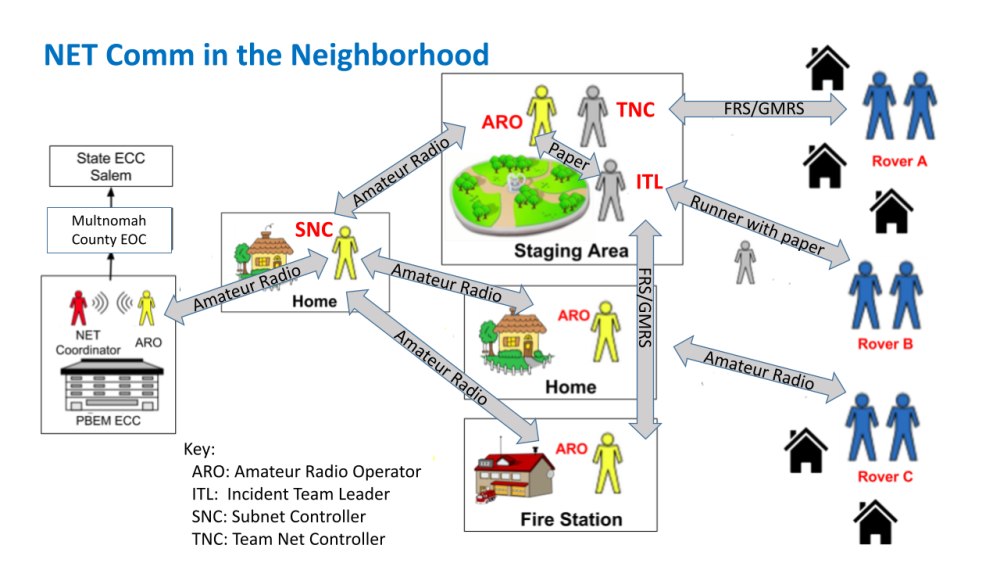Communications to the EOC via Amateur Radio
a. In the event mobile phone service is disrupted, NET AROs can attempt to communicate with the ECC via the VHF Amateur Radio system. Optimally, every team will have an Amateur Radio Operator and a backup operator in case the primary ARO is not available.In an emergency deployment, an ARO using VHF radio must accomplish three goals:
- First, the ARO must be able to communicate with the Incident Team Leader. The first assignment of every NET ARO is to support the Incident Team Leader and take direction from that person.
- Second, the ARO must have a means to a subnet control who is in touch with the ECC radio room.
- Third, the ARO must be prepared to relay messages between the Incident Team Leader and the ECC.
Team Leaders and AROs should work out ahead of time how to accomplish these three goals, to prepare an approach that best suits resources available to the NET, and to include that information in the NET’s Operation Plan. The common solutions are listed below from most common to least common.
1. In the event of a disaster, the NET ARO deploys to the NET Staging Area with a portable radio and works face to face with the Incident Team Leader, and relays messages with the handheld or portable radio equipment (see “Staging Area” in figure below).
2. An ARO has radio equipment at home that is more powerful than any portable amateur radio. Therefore, the ARO plans to shelter in place during a disaster if safe to do so, use FRS/GMRS to communicate with the Incident Team Leader, and relay messages to the ECC with the radio equipment located in their home (see “Home” in figure below).
3. In another scenario, the NET ARO deploys to the nearest fire station to use the Fire Station Orange Go-Kit and antenna located there. The ARO reaches the Incident Team Leader via handheld GMRS and relays messages between the NET Staging Area and the ECC from the fire station (see “Fire Station” in figure below).
Whether an ARO deploys to the NET Staging Area, remains at home with radio equipment, or deploys to the nearest fire station to use the radio kit available is a decision that the ARO and TL must consider in operations planning. Any option that works best for the team is appropriate, so long as the ARO and the TL are in communication with each other (e.g. by FRS radio).
In all of the above cases the ARO will normally communicate with the ECC via a regional subnet controller. The subnet controllers have radio equipment and a communication path that allows them to use simplex communication with the ECC Radio Room without the use of a repeater. In many cases the subnet controller will use Winlink digital communication to increase the speed and accuracy of communication with the Radio Room..
b. The ARO checks in with the Multnomah County Amateur Radio Emergency Service (ARES) Resource Net Controller on the Resource Net MC-2. Checking in with MC-2, the ARO gives his or her FCC call sign and frequency, and waits for acknowledgement from the net control operator. Once recognized, the ARO then provides the following information:
- Name
- FCC Call Sign
- Any other information deemed necessary by the ARO or requested by net control
c. The ARO then declares that she or he already has an assignment (which is to support the NET) and is switching to the PBEM tactical net. d. If no contact is possible on the Multnomah County ARES Resource Net (MC-2), AROs should attempt to make contact with a Multnomah County ARES Net Controller via Multnomah Resource Net Simplex (MC-12). e. After checking in with the Resource Net Controller (or attempting to check in) the ARO switches over to the tactical net reserved for PBEM at MC 8, followed by MC 9 if there is no answer at MC 8. The ARO will check in with the PBEM Tactical Net Controller, sited at the ECC, and repeat the same information given for the Multnomah County Resource Net check in. f. Regular radio traffic and monitoring commences. The NET Tactical Net Controller will contact each team periodically for status reports and issue deployment authorization messages or assignments as necessary. AROs should use the NET Tactical Net also to request resources and information. AROs will handle life threat radio traffic on a different tactical net: MC-6. This s the only circumstance under which an ARO should communicate NET activities on a frequency other than the NET Tactical Net unless directed differently by the Net Controller.
